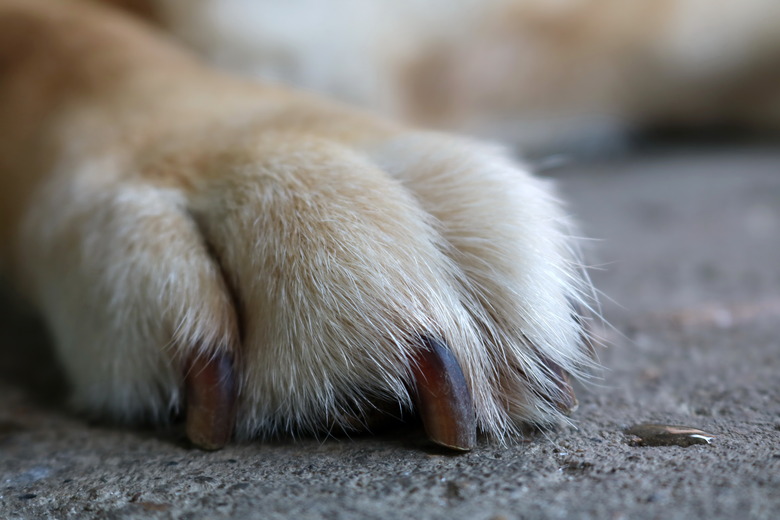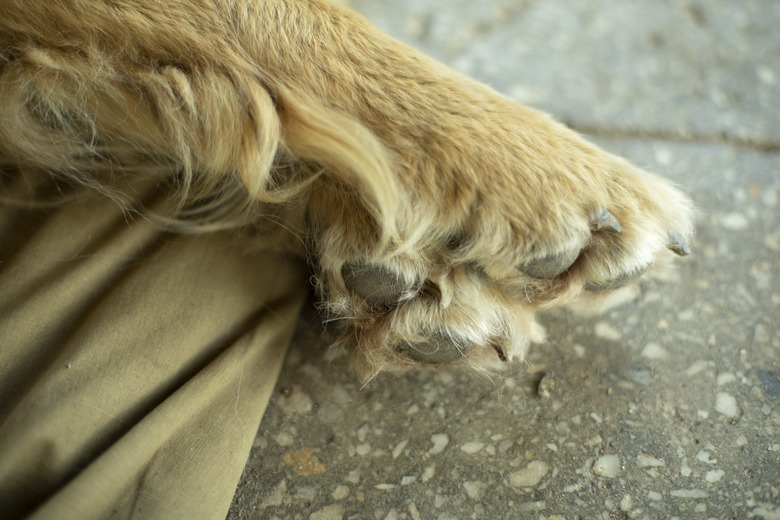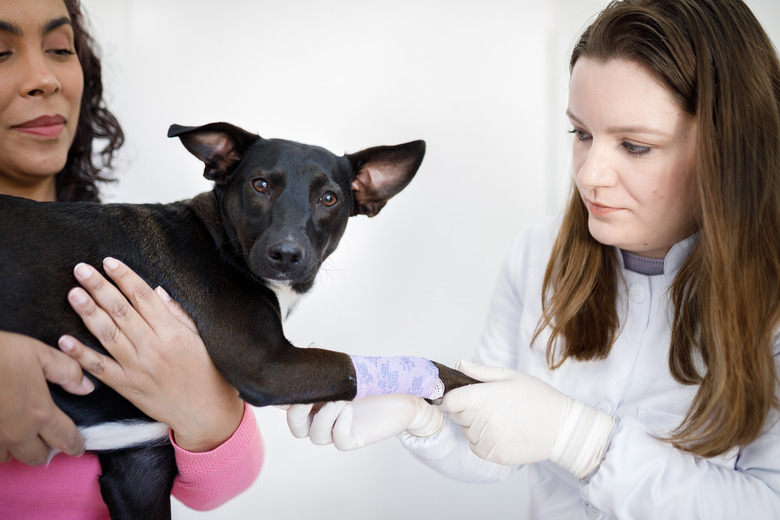Blister On A Dog Paw: Causes, Symptoms, And Treatment For A Dog's Sore Paw
When you go hiking or jogging, you probably put on a comfortable pair of shoes that will cushion your feet, protect your feet from foreign objects, and prevent blisters. In fact, you probably can't imagine doing anything that involves running or hiking without proper footwear, but dogs tend to spend almost every minute of every day walking on bare paws no matter what they're doing.
Paw problems are not uncommon in dogs. When your dog gets scrapes, lacerations, burns, blisters, and abrasions, it's critical that you properly care for the injury so it can heal as quickly as possible. You may be able to treat the injury using home remedies like proper first-aid techniques if it is a simple one, but more serious injuries, those that don't heal, and infections require a veterinarian's care.
Immediate care for cuts on a dog's paws and paw pads
Immediate care for cuts on a dog's paws and paw pads
Clean the wound. When your dog has a sore paw due to a scrape, cut, or tear in the paw pad, you need to clean the wound by flushing it with warm water, normal saline, or an antiseptic wash. While doing this, look for obvious debris, such as rocks or glass.
Flush and remove debris. If you see debris, remove it by flushing it with water or pulling it out with tweezers, acting as gently as possible and assuming that the paw is tender. Do not attempt to take out anything deeply lodged into the wound and instead take the dog to the veterinarian to have it removed.
Control the bleeding. Using a clean towel, apply pressure to the wound. Most cuts will stop bleeding after only a few minutes, but deep wounds can take longer to dry. If the wound is still bleeding after 10 minutes, bring the dog to an emergency veterinary clinic immediately.
Dab on styptic powder. For small or minor cuts, use a small amount of styptic powder. Just dab a cotton swab into the powder and gently apply the powder to the wound. Styptic powder often comes in a tube that is easy to pack along on a walk or hike. The squeezable formula may contain a numbing agent to keep your pet from getting distressed from discomfort.
Evaluate the injury. Once the bleeding has stopped, evaluate the severity of the injury. If it is particularly deep or jagged, if you can't get the wound free of debris, or if you notice anything likely to result in infection, such as fecal material, a rusty piece of metal, or an animal bone, take your dog to the veterinarian to ensure proper care for these potential complications.
How do I bandage a cut paw on my dog?
How do I bandage a cut paw on my dog?
Follow these steps to bandage your dog's cut paw:
- Apply antibiotic ointment to a pile of nonstick gauze pads and place them on the clean, dry wound. Using multiple pads will provide a cushion and absorb blood.
- Wrap the paw up to the ankle with self-adhesive medical wrap. Using a bitter-tasting self-adhesive wrap will help keep the dog from biting or chewing it. Although self-adhesive bandaging won't stick to skin or fur, don't apply it directly over an open wound. Apply the bandage at about 50 percent stretch, making sure the bandage is secure but not too tight — you should be able to slide two fingers between the bandage and the leg.
- Rebandage the wound daily while it heals, cleaning it and applying antibiotic ointment every time.
- Be sure the paw is thoroughly dry before bandaging it, as applying a bandage to a paw still wet from cleaning can cause a skin infection. If necessary, use a blow dryer to help the fur dry quicker, making sure the blowing air is not hot.
- Keep the bandage dry and apply a commercial bootie or a plastic bag and some tape whenever your dog goes outside. Keep your dog from overexertion and from chewing on the bandage, which may require using an anti-chewing spray or a cone.
- Watch for signs of infection, such as swelling, warmth, a bad odor, or a moist discharge, and take your dog to the veterinarian, as it may be infected. Preventing infection and treating infection early is important for all dogs and especially for dogs with other health issues, such as diabetes.
- If it is still bleeding after two days or gaping open, contact your veterinarian. Stitches may be needed to keep the wound closed while healing.
How to treat dog blisters on paws
How to treat dog blisters on paws
Dogs can get blisters and burns due to friction from their paw pads rubbing together or from walking on a hot surface, such as scorching pavement or sand. To care for a dog paw pad blister or burn:
Gently wash the paw with normal saline or an anti-bacterial wash. Apply a pet-safe antibiotic ointment and loosely bandage the paw, securing it up to the ankle to keep it in place. Change the bandage daily until it has healed.
Evaluate the damage when you first notice a blister. Do not pop a blister or cut off the loose skin if the blister has already popped. If the burn is severe, the blister is noticeably deep, the pad becomes discolored or is peeling, or the injury gets infected, take your dog to the veterinarian. The dog may need to be prescribed oral antibiotics and pain medication.
Signs of sore dog paws
Signs of sore dog paws
Limping. Lameness is a major sign that your dog has a sore paw. Dogs may also hold the leg with the sore paw up in the air a bit in an attempt to keep from walking on it and causing more pain.
Excessive licking. Sometimes, a dog will continually lick an area that is sore, like an affected paw. This is especially noticeable in dogs who don't normally lick their paws, but when any dog concentrates on one paw, that's a signal for you to take a closer look.
Redness or swelling. You may not notice that your dog's paw is red or swollen until you see the paw while the dog is licking it or examine it because you notice limping or holding one paw off the ground. Redness and swelling indicate inflammation and can be signs of infection, which merits a call to your dog's veterinarian.
Causes of sore dog paws
Causes of sore dog paws
A dog's paws can become sore for many different reasons, including:
Stepping on sharp objects. Gently check the paw for a puncture wound or cut and if possible, try to see if anything is embedded in the paw pad or stuck to it, like burrs. The absence of embedded debris doesn't necessarily mean an injury didn't occur, however; the object may have fallen out, or it could be so deep into the pad that you can't see it.
Friction, burns, bites, and blisters. Walking on rough surfaces, like gravel or rocks, can make paw pads sore or cause inflammation, also known as pododermatitis. Walking on hot pavement can easily burn a dog's paw pads. The burn or friction can also cause painful blisters, while insect bites can be itchy and cause pain and swelling.
Traumatic injury. Falling or jumping from a high perch, fighting or being attacked, running into something, and certainly being hit by a car can all cause paw injuries and sore paws in a dog.
How to prevent sore dog paws
How to prevent sore dog paws
Dog boots. Consider fitting your dog with a pair of dog boots that cover the dog's toes and paws so that their feet are protected.
Walk your dog on smooth surfaces. Avoid walking on rough surfaces, like gravel, for long periods of time. Also avoid hot surfaces.
Be cautious while exploring. Some dogs were born to hunt. They just love venturing into the woods and sniffing out and uncovering whatever they may find. Some areas are inherently safer than others, though, so try to divert their attention to places where you can see the ground and know it doesn't contain glass, nails, or other debris that could potentially cause an injury.
Examine their paws regularly. Just as you examine your dog for ticks, fleas, and bumps on their body, check their paws regularly and especially after dog walks or hikes in the woods. Wash off dirt so you can see the paw pad. If there is a problem, getting to it early is always best.
The bottom line
The bottom line
Dogs walk on their paws, so regular paw care is important to keep their paws from becoming injured and sore. Preventing sore dog paws is not as difficult as it may seem once you know the causes. By checking your dog's paw pads often, you can find and deal with problems before they worsen and become infected. For simple wounds, it's fine to use home remedies, like cleaning wounds with normal saline, applying antibiotic ointment, and wrapping the paw. As always, though, if your dog's paw seems sore and you can't determine why or if a wound doesn't heal, seek prompt veterinary care.


